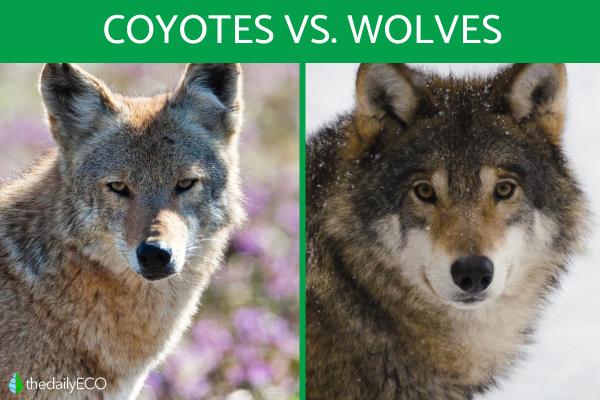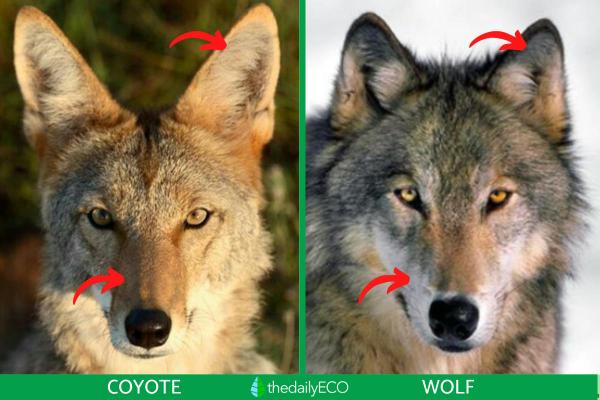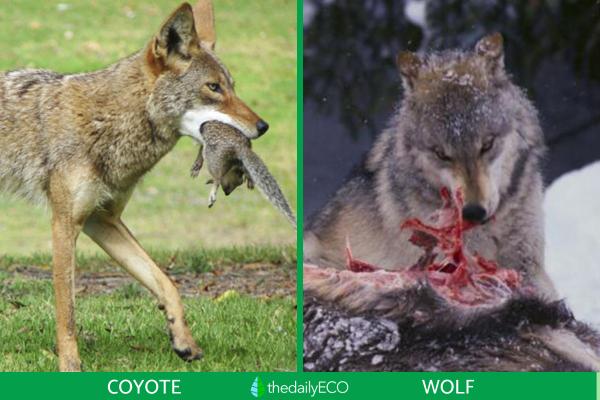
Both the coyote and the wolf are mammals. More specifically, they are carnivorous animals found in the family Canidae. The members of this group are known as canids and they share various physical and behavioral similarities. They also have key differences which are used to tell species apart from each other. The reasons for these differences can be due to human interference. Although the domestic dog is also a canid, we shouldn't have much trouble spotting the difference between a wolf and a Pug. Other differences are due to evolutionary adaptation and natural selection. This is the case when we make a coyote vs. wolf comparison.
To understand these two types of canid, we want to look at the difference between coyotes and wolves. thedailyECO does so by comparing their taxonomic, physical and behavioral differences. These differences
Taxonomic differences between coyotes and wolves
As stated in the introduction, both the wolf and coyote belong to the family known as Canidae. Within this taxonomic grouping, we can find other canids which include:
- Domestic dogs
- African wild dogs
- Bush dogs
- Foxes
- Jackals
- Dholes
- Culpeos
In terms of evolution, it is believed that the wolf and the coyote developed from a common ancestor. It wasn't until around 1.1 million years ago that it is believed wolves and coyotes diverged into two separate species. Both the coyote and wolf are considered individual species, but they have many different subspecies. Below we look at the taxonomic rank of both the wolf and the coyote
Coyote taxonomy:
- Kingdom: Animalia
- Phylum: Chordata
- Class: Mammalia
- Order: Carnivora
- Family: Canidae
- Genus: Canis
- Species: C. latrans
Wolf taxonomy:
- Kingdom: Animalia
- Phylum: Chordata
- Class: Mammalia
- Order: Carnivora
- Family: Canidae
- Genus: Canis
- Species: C. lupus
As you can see, the coyote and wolf are from the same genus, but are separated as species. It is for this reason coyotes were once known as the prairie wolf or bush wolf, but this is no longer common.
Physical differences between coyotes and wolves
One of the reasons coyotes were once known as bush wolves is because they look very similar to the wolf. Otherwise known as the gray wolf, wolves have thick gray fur which is denser and fluffier during the winter. Coyotes possess a similar physical appearance, with facial shape and body morphology also bearing similarities.
Now we have identified some of the physical similarities between wolves vs. coyotes, we can look more closely at their differences:
- Size: we can see that wolves are larger than coyotes as the average adult wolf is 31–33" (80–85 cm) tall, while the coyote is usually less than 25" (65 cm) in height. This size difference is also evident in weight, adult male wolves can measure up to 176 lb (80 kg) and the equivalent in coyotes is only around 45 lb (20 kg). The coyote's lighter weight gives them the advantage of being faster than wolves and generally can cover longer distances in a shorter time.
- Feet: if we were to find only the paw tracks of these two animals, we would see the coyote has smaller feet than the wolf.
- Tail: the difference in tail position between these two animals is particularly noticeable when they are running. The wolf keeps their tail horizontal while running and the coyote lowers and keeps it pointed toward the ground.
- Snout: the muzzle of coyotes is thinner and narrower than that of wolves, which is more rounded, elongated, and solid.
- Ears: the ears of wolves ears are rounded while coyote's are beak-shaped. Also, those of the coyote are proportionally longer than those of the wolf.
Learn more about different types of mammal with our article on even-toed ungulate definition and examples.

Behavioral differences between coyotes and wolves
Although both wolves and coyotes are carnivorous canids, they have some key differences in terms of their behavior. These include their activity levels and temperament. Find out more with this behavior comparison between coyotes and wolves:
- Wolves are generally calmer and more leisurely. Conversely, coyotes are considered more nervous, wanting to be aware of what is happening around them and making anxious patrols.
- Despite their differences in demeanor, wolves are considered much more aggressive than coyotes. Once they have a target they don't stop until they catch it. They are also very territorial with their space and can be aggressive with any threat.
- Since the strength of the wolf is considerably greater than that of the coyote, we can say that wolves are more dangerous to humans and larger animals.
- Wolves perceive any type of canid as their competition, including coyotes. They respond to them very aggressively. They are also aggressive with humans, while coyotes do not fear us as much. For this reason, it is common to confuse coyotes with wolves. Regardless, we cannot ignore the fact that any wild animal can be aggressive. The coyote may also be defensive in their territory.
- Vocal communication is extremely important in canids. Wolf and coyote howls can be differentiated if you pay attention to them. The wolf has a low howl which makes a rising and falling sound. The coyote emits a sound with a similar tune, but higher pitched and sounds like a piercing scream. In both it is common to hear a response in the distance from another member of their species.
Differences in diet between coyotes and wolves
Canids are carnivorous by nature, both the wolf and the coyote feed mainly on large hoofed animals to satisfy their need for animal protein. They also supplement their diet with small rodents such as squirrels and mice. Both will also eat large portions in advance so they can survive for longer periods without eating. These animals use this stored food to feed their young once they return from a hunt.
The coyote and the wolf have shared geographical ranges, but the wolf tends to displace the coyote due to the aforementioned perception of threat from other canids. Given the competition and displacement that exists from wolves, coyotes have learned to supplement their meat-based diet with other foods that can be found, such as human garbage and carrion.
For this reason, it is very common to find coyotes living near human settlements and rummaging through garbage cans or even attacking domestic animals . They can complement with insects and fruits from the forest. Some coyotes may even team up with badgers to search for rodents underground.
Learn about other types of living and extinct predators with our article on the different types of megafauna.

Differences in habitat between coyotes and wolves
We can differentiate both canids according to their geographical location. Coyotes are only found in North and Central America, while wolves inhabit the entire northern hemisphere of the planet. It is only in America they can overlap their distribution and coincide, as detailed above.
In the past, wolves were distributed as far as the equator, but today their range is much more restricted. In particular, they have a greatly reduced southern distribution. This is because the habitat of the coyote and the wolf is closely related to their biological adaptations to the environment.
As we have mentioned, the wolf has a specific diet and is restricted to large prey. Exceptions occur only usually during times of food scarcity or they are very hungry and do not detect larger prey. In these cases they can eat small animals or even carrion.
In terms of behavior, the wolf has not had a good history of coexistence with man given its aggressiveness. Although the coyotes have been known to attack humans, they are seen as more sociable. This has meant that the wolf has not adapted to the new anthropogenic era, being banished and even hunted to extinction in many regions by humans. On the contrary, the coyote has found food in urban agglomerations and has proven not to be as great a threat to man as the wolf.
Despite these characteristics, we must not overlook the strong pressure humans have placed on wolf communities. While neither the wolf nor the coyote are considered endangered on a global scale, various local populations have been eradicated. This is especially so with wolves. Some rewilding propositions have considered reintroducing wolves to certain areas to help ecosystems. Their role as a predator can improve various aspects of certain areas such as preventing overgrazing from herbivorous animals.
Learn about the various habitats of wolves, coyotes and other animals by looking at the difference types of ecosystems.
If you want to read similar articles to Difference Between Coyotes and Wolves, we recommend you visit our Facts about animals category.
- Beatty, R., Beer, A., & Deeming, C. (2010). The book of nature. Great Britain: Dorling Kindersley.